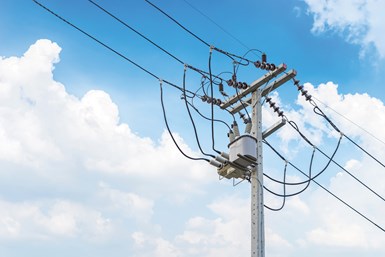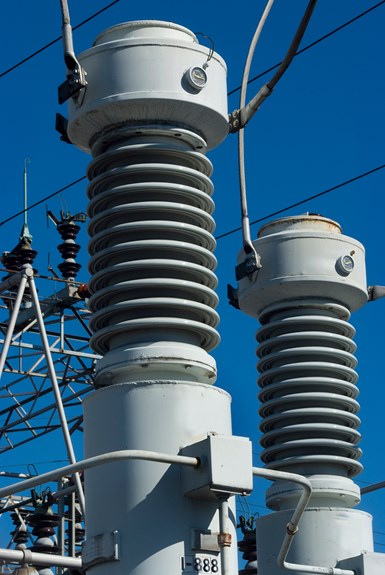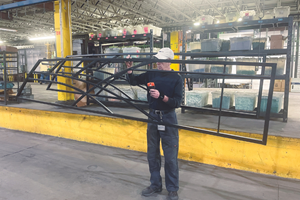Choosing Coatings for Best Transformer Performance
Protecting transformers from weather, wear and chemicals is the job of the coatings that are chosen by the power supply manufacturer. Knowing the most appropriate coatings and the best specifications for an application is critical to successfully keeping corrosion at bay.
Transformers must be protected from corrosion, the number one threat to this component. By implementing the right coating technology and systems, transformer life can be extended without the worry of corrosion interfering with performance. Photo credit: PPG Industrial Coatings
Transformers are among the most important and expensive components of an electrical substation. Responsible for the widespread distribution of power (both high- and low-voltage electricity), transformers are sensitive to how they are constructed, maintained and protected, which are key factors in their long-term operational performance.
Although transformer manufacturers spend much of their time on the design and inner workings of this power supply component, the coatings are often an afterthought. Maria Lamorey, commercial strategy manager at PPG Industrial Coatings, encourages manufacturers to lean into finding the best coating system because it can dictate the equipment’s performance.
Transformers must be protected from corrosion, the number one threat to this component. By implementing the right coating technology and systems, transformer life can be extended without the worry of corrosion interfering with performance. Leveraging the right coating technology and working with a good paint supplier that understands all the layers and will test the system and help with specifications, transformer field performance can be predicted and optimized.
Lamorey explains that not only is the substrate painted but also the paint must adhere to the pretreatment on the substrate making it an important part of the process. Also, understanding the types of metals and the design of the transformer being coated is necessary as well as paint specifications. Many questions must be answered prior to the coating process in order to develop the most beneficial coating technology for an application, she says.
Minor changes can yield major results
Any time a change is made in the transformer’s design, production, or pretreatment, it can yield different results for the coating. Switching to another metal supplier in response to supply chain issues or changing lubricant and coolants used to fabricate the metal are common occurrences that must be brought to the attention of the paint supplier by the transformer manufacturer. These factors determine what changes might be required within the coatings system.
“A slight change could have a huge impact on the paint line and the paint’s ability to adhere,” Lamorey explains. “So, it might require that the pretreatment step needs an adjustment or a different pretreatment to prepare that metal for the best coating.”
She emphasizes that a good paint supplier that understands all the layers will be able to test for alterations in the water or in the pretreatment system. They can identify modifications a steel supplier might have made in its material, for instance.
A change in metals, especially a jump to galvanized metals, has a significant impact on the coating. Paint does not adhere to galvanized metals well, but if that type of metal must be used, the pretreatment system might need to be changed as well as primers and topcoats.
For specialty transformers, sometimes two dissimilar metals are combined. This can cause premature corrosion called galvanic corrosion, according to Lamorey. Therefore, she recommends creating a transformer using one metal or one metal type, if possible.
A quality paint supplier will also help the manufacturer write a full unit specification for the paint system to ensure that the coating, which is the first line of defense against corrosion, will protect the equipment to the highest degree.
Building a smart coatings method
Creating the most appropriate paint specification requires consideration of a transformers’ service environment, exterior conditions and component shape. If a paint specification is already in use, periodically reviewing these coatings technologies is recommended to ensure that manufacturers stay abreast of the latest innovations that can maximize the service life and reduce warranty claims for their products.
Lamorey points out that for transformers, powder coatings should be implemented rather than liquid. Because powder is an electrostatic dry-finishing process that applies charged powder particles to a grounded part, it adheres to all areas of the metal better than its liquid counterparts. Due to newer innovations in powder, such as High Edge, powder should be a strong consideration for the coating technology.
To ensure that transformers perform reliably throughout their service life, Lamorey explains it is vital to test them rigorously against the challenges they will face in the field. This includes testing in extreme fluctuations in
To ensure that transformers perform reliably throughout their service life, it is vital to test them rigorously against the elements they will face in the field. The paint’s base coat protects against corrosion and the top coat provides UV protection. Photo Credit: PPG Industrial Coatings
temperature, which is called thermal cycling. “Steel expands in higher temperatures and contracts in colder temperatures, creating stress that can damage the substrate,” she says.
Using insulative coatings might not always be advised, she adds, because they tend to retain heat, which can change the material and mechanical properties of the metal in hot climates.
Component shape is another important consideration that matters when determining the best coatings. Sharp edges, recessed and intricate shapes are the weakest points for coatings to adhere to. The paint tends to pull away from these areas of the transformer. Although primers and topcoats are used to overcome this challenge, there are coatings that are especially formulated for edges and other difficult areas that perform better and are more efficient than layering with other coatings.
A sharp system for edges
Edge corrosion is one of the most common challenges for power equipment manufacturers. When parts are painted on the line, a visual inspection typically shows sufficient paint coverage on edges. However, during the heated cure time is when coatings can pull away from edges, reducing film thickness.
High edge powder coatings such as PPG’s Envirocron Extreme Protection Edge provide consistent film thickness across the part from flat, straight surfaces to seams, corners and sharp edges that are common on transformers. Because they require only one coat and are direct-to-metal, reclaimable and eliminate the need to finish edges with mechanical edge rounding or blasting equipment, these advanced powder formulas can deliver significant savings in materials, labor, equipment and time, according to Lamorey. They also provide excellent corrosion resistance and ensure color consistency across the component.
However, if sharp edges can be avoided during fabrication, Lamorey might suggest that manufacturers consider other ways to design the component. “Sometimes I’ll see fins that are meant to provide air flow inside the part, but do they have to be that sharp of an edge?” she says. “Can you give it a little more rounded finish so you can get the coating onto it? So, it is important to factor in beyond just the look, but how to paint the component when it’s completed.”
Other considerations
Along with the service environment and design of transformers, it is also critical to understand the specifications that a surface finish must meet prior to choosing the best coatings method. These include color, gloss, product handling and storage and, of course, regulatory standards.
Choosing an optimal color for transformers is critical because it determines how sunlight reflects off the component, which in turn predicts the transformer’s temperature. Therefore, white coatings are popular because they keep equipment cooler. However, light colors are often good enough and blend into the outdoor environment well. For example, a light shade of green is commonly used because it blends into the neighborhoods. And any components on the ground are often painted gray to blend into the concrete.
High gloss coatings are reflective as well. Variations in gloss can cause the same color on a piece of equipment to appear as different shades.
Coating manufacturers suggest specific rules for paint handling and storage which should be followed by the transformer manufacturer. These specs include an acceptable temperature exposure range and fixed expiration dates to ensure inventory is rotated properly.
In addition to the regular standards of UL and IEEE, specifications should be written to include testing that predicts field performance.
Related Content
Curing Oven Basics
Simply heating up the substrate does not cure the coating. There are many variables to consider when choosing the best cure oven for your application...
Read MoreAdjusting Current and Voltage When Powder Coating
Which manual powder coating gun setting is better to adjust, voltage or current? Jeff Hale of Gema USA discusses when to use different settings on your powder gun to achieve optimal results.
Read MoreAn Altruistic Growth Strategy Puts People First
Professional Plating emphasizes investing in its team and fostering a supportive environment on the shop floor.
Read MorePowder Coating Overcomes Post Forming
Six Sigma methodology, open communication, and collaboration produce results for leading boat manufacturer.
Read MoreRead Next
Finishing Temperature-Sensitive Material with UV Powder Coating
Quality issues with pre-finished components led Global Building Products on a search to discover a new solution for its temperature-sensitive materials.
Read More12 Ways to Improve Your Powder Coating Quality
Often overlooked powder coating procedures that can help you elevate your quality, streamline your operations and improve your profitability.
Read MoreCorrosion Resistance Testing for Powder Coating
Salt spray can be useful to help compare different pretreatment methods and coatings but it does not tell us much about the corrosion resistance of a part over time in the field. Powder coating expert Rodger Talbert offers insights into how to get a better idea of how to improve a part’s corrosion resistance in the real world.
Read More
























